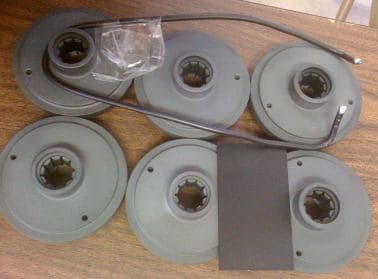
Home of the world famous 'finishing.com HOTLINE' since 1989
-----
Bead blasted parts coming out gray instead of black in Type II anodizing
We are an anodizing job shop. We ran several 6061 parts with a glass bead blast finish. We hoped to get them fairly dark black. They came out quite gray instead of black. Other parts on the same rack came out fine, and the parts had good electrical contact. It seems the bead blast may be a problem. Any ideas on getting good black parts when they are bead blasted?

anodizing job shop - Rohnert Park, California
August 4, 2009
First of three simultaneous responses --
Bead blast scatters the reflected light, so it might. The only way to eliminate it as a possibility is to run a few scrap parts that are not blasted in a few loads and compare them to the blasted parts in he load.
James Watts- Navarre, Florida
August 6, 2009

Aluminum How-To
"Chromating - Anodizing - Hardcoating"
by Robert Probert
Also available in Spanish
You'll love this book. Finishing.com has sold almost a thousand copies without a single return request :-)
Treatment &
Finishing of
Aluminium and
Its Alloys"
by Wernick, Pinner
& Sheasby

on eBay or Amazon
or AbeBooks
(affil link)
Second of three simultaneous responses -- August 6, 2009
Joe
How were the parts prepped/cleaned prior to anodize?
What is the coating thickness?
- Colorado Springs, Colorado
Third of three simultaneous responses --
On flat metal the pores build exactly perpendicular. On roughened blasted metal these pores are random and therefore reflect the light differently. In your next message tell us whether you are dyeing Type II or Hard Coating Type III. We cannot tell how you are getting a black color, so tell us. either way, a rough surface will render a different shade from a smooth surface.

Robert H Probert
Robert H Probert Technical Services
Garner, North Carolina

August 6, 2009
As I mentioned in my post, this is Type II anodizing. Parts were cleaned in Ardrox 6333A degreaser, etched in Chemetall Oakite 160, and deoxed in Deoxidizer LNC. Parts were then anodized, and dyed black. If you look at the photo, the wire laying on the parts was the racking wire which is the same alloy (6061) as the parts and was used to rack these parts- the color came out correctly on the wire. The rectangular plate sitting on the parts is a sample of the black color as it came out on other non-bead blasted parts run in the same load (it is actually darker than it looks, there is a reflection in the photo). The bead blast is definitely the issue, I know that already. The question is how to improve the darkness of the bead blasted parts, to have them come out blacker, not so gray. I know it can be done. The question is how. Thanks in advance for the help.
Joe Osborn- Rohnert Park, California
August 7, 2009
I'll agree with the previous response about the issue of light refraction, making it more difficult to get a visually appearing black color on sand/bead blasted parts.
However, judging from the picture, they should look quite a lot better (blacker) than what I'm seeing. A common mistake I've seen many anodizers make is forgetting to calibrate their coating thickness gauge to the blasted surface prior to verifying coating thickness. A blasted surface will actually measure .0005" higher than what the actual coating thickness is. So basically, the coating may not be thick enough to adequately accept the dyestuff.
Secondly, blasted parts need to be thoroughly rinsed, a 5 min dip in a 10% HNO3 solution (after the anodize rinse) could be very beneficial in aiding the rinsing process (HNO3 "cuts" sulfuric acid very well), followed by another thorough DI water rinse prior to dyeing.

Marc Green
anodizer - Boise, Idaho
August 12, 2009
No dead threads!
Your Q, A, or Comment puts this thread on The Finishing.com HOTLINE.